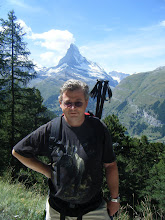The ultimate comfort food
One of the nice things about living in Switzerland is that you can get these miniature chickens (called coquelets Suisses) that feed one person (if you're greedy) so you can even have roast, stuffed chicken when you live on your own.
Of all the things I remember my about my late mother's cooking it is, perhaps, her stuffing that stands out so I still like to have it with roast chicken.
Like her, I use sausagemeat, but not too much. The meat from two pork sausages broken up with your fingers (or one Swiss saucisson à rotir chopped up finely) could be blended into about 100g breadcrumbs, add an onion, chopped finely and softened in oil, some sage (dried is fine), thyme, salt and pepper. Mix everything in a bowl and add a beaten egg to bind it all together. This will stuff two coquelets, including a little bit in the craw of each one so it makes a nice meal for two hungry people (or you can freeze half the stuffing).
Grease the chickens well and place, face down, in a roasting tin. Put in the oven at 200 for 25 minutes, then turn them right side up, sprinkle with salt and cook for another 25 minutes (this way you get a nicely browned breast that doesn't dry out).
During the second leg of the roasting time, take four to six peeled potatoes, put in a saucepan with cold water and bring to the boil. Simmer for 5 minutes, then drain off the water. Now - and this is important - take the pan, holding the lid on tight (use oven gloves) and give it a GOOD shake. This will make the potatoes nice and floury on the outside. In the meantime, heat a little oil, butter (or beef dripping, goose fat or duck fat) in another roasting pan in the oven for a few minutes. When the fat is hot, take the pan out, put on a hot ring, and put the potatoes in one by one, making sure thy are well coated in fat.
By now, the chickens will be ready, so you can transfer them to a warmed plate and cover with foil. Turn the oven up to 230 and put in the potatoes. They will take 35 minutes or so (the chicken will stay warm) but should be taken out and turned over roughly halfway through.
This gives you time to make the gravy. Drain off most of the fat, add a dessertspoon or so of flour to what's left and blend it into a paste, scraping all the brown, grungy stuff aff the pan into it. Separately, mix a cup or so of chicken stock with a half a glass or so of red wine. Add this slowly to the flour paste, blending as you go. If the liquid is too runny you can thicken it a bit afterwards by bringing it to the boil in a small saucepan (if all else fails - but only if all else fails - add Bisto).
When the potatoes are ready everything else should be ready too. You can serve with some green vegetables or, if it's winter, my special cauliflower cheese (which merits a blog on its own some day).
You'll need to double roughly the quantities of stuffing for a normal sized chicken for 4 people or so (which takes longer to cook, of course). Or you can use guinea fowl, which is like chicken only more so (as Winnie the Pooh might say, it's the same as chicken only different). Because of the high breastbone on guinea fowl, you can't do the trick of starting it upside down. Instead, lay straky bacon strips over the breast to keep it moist - they can be the chef's treat afterwards (if he or she isn't worried about calories).




